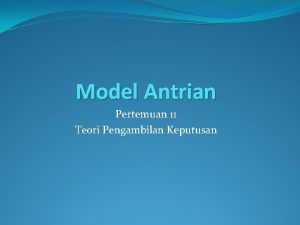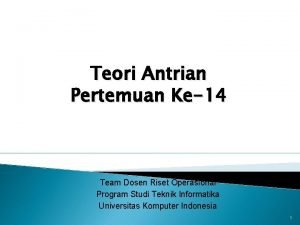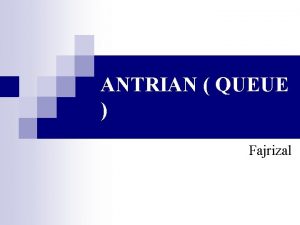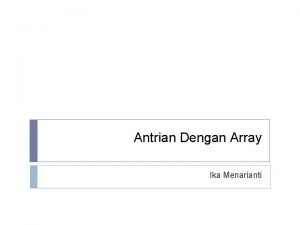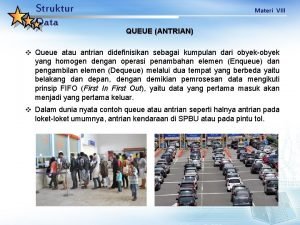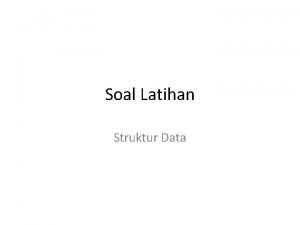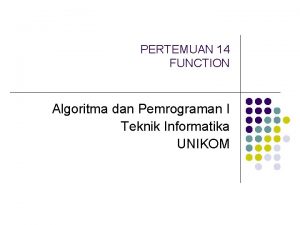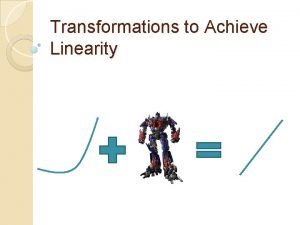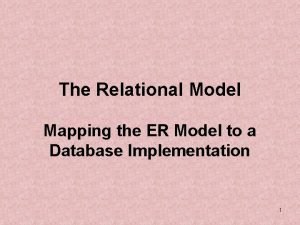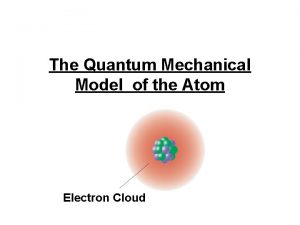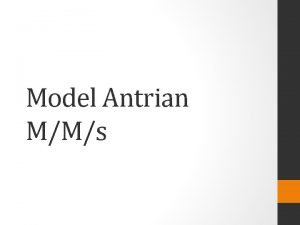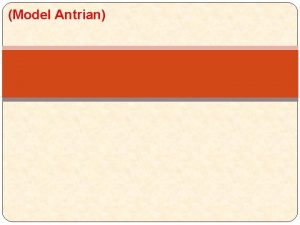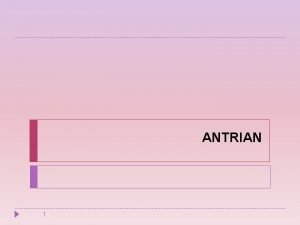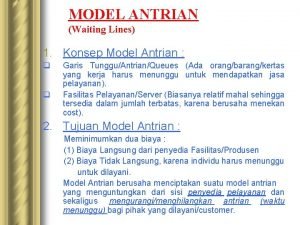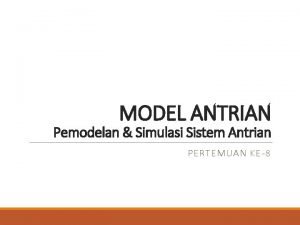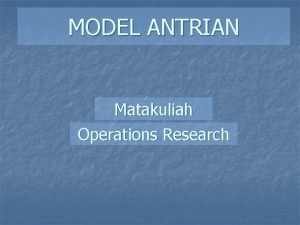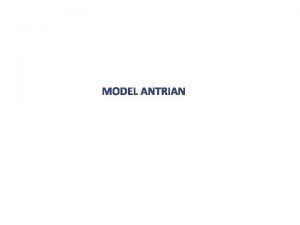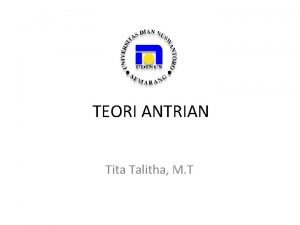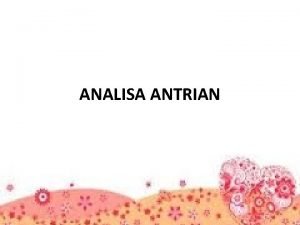Model Antrian MM1N R Rumani M rrmittelkom ac















- Slides: 15

Model Antrian M/M/1/N

R. Rumani M / rrm@ittelkom. ac. id Telkom Institute of Technology 25 September 2020 M/M/1/N (single server) 2

= (1 - r) / (1 - r. N+1) R. Rumani M / rrm@ittelkom. ac. id Telkom Institute of Technology 1. Form Balance Equations: 2. Solve for P 0: or P 0 + (l/m)1 P 0 + ×××× + (l/m)N P 0 = 1 P 0 {1+ (l/m)1 + ×××× + (l/m)N } = 1 P 0 = 1 / { } 25 September 2020 M/M/1/N (cont. ) 3

, for n = 0, 1, 2, . . . , N Hence, N L = S n Pn n=0 1 -r N d = ----- r S ----- rn n=0 dr 1 - r. N+1 1 -r d N = ----- r ----- S rn 1 - r. N+1 dr n=0 R. Rumani M / rrm@ittelkom. ac. id Telkom Institute of Technology So, 25 September 2020 M/M/1/N (cont. ) 4

R. Rumani M / rrm@ittelkom. ac. id Telkom Institute of Technology 25 September 2020 M/M/1/N (cont. ) 5

R. Rumani M / rrm@ittelkom. ac. id Telkom Institute of Technology As usual (when s = 1) Lq = L - (1 - P 0) W = L / le , where le = l (1 - PN) Wq = Lq / l e 25 September 2020 M/M/1/N (cont. ) 6

M/M/1/N Example The unisex barbershop can hold only three customers, one in service and two waiting. Additional customers are turned away when the system is full. Determine the measures of effectiveness for this system : a. Traffic Intensity (l / m) b. The probability that there are three customers in the system c. The expected number of customers in the shop d. The expected time spent in the shop e. Then the average length of the queue f. The waiting time in the queue g. Compare the server utilization (r = le / m) before and after capacity constraint

R. Rumani M / rrm@ittelkom. ac. id Telkom Institute of Technology The traffic intensity is l / m = 2 / 3. The probability that there are three customers in the system is computed by Pn = P 3 = {(1 -2/3) (2/3)3} / { 1 - (2/3)4} = 8 / 65 = 0. 123 25 September 2020 M/M/1/N Example 8

R. Rumani M / rrm@ittelkom. ac. id Telkom Institute of Technology The expected # of customers in the shop is given by 2/3 {1 - 4(2/3)3 + 3(2/3)4} 66 L = ----------------= -----{1 - (2/3)4} (1 - 2/3) 65 = 1. 015 (customers) Now, the effective arrival rate, le , is given by le = l (1 - Pn) = 2(1 - 8/65) = 2 × 57 / 65 =114/65 = 1. 754 (customers/hour) Then W can be calculated as W = L / le = 1. 015 / 1. 754 = 0. 579 (hour) 25 September 2020 M/M/1/N Example (cont. ) 9

P 0 = (1 - r) / (1 - r. N+1) = (1 - 2/3) / {1 - (2/3)4} = {1/3} / {65/81} = 27 / 65 = 0. 415 Then the average length of the queue is given by Lq = L - (1 - P 0) = 1. 015 - (1 - 0. 415) = 0. 43 (customer) R. Rumani M / rrm@ittelkom. ac. id Telkom Institute of Technology In order to calculate Lq, first determine P 0 as 25 September 2020 M/M/1/N Example (cont. ) 10

Finally, the waiting time in the queue is determined by Little’s equation as Wq = Lq / le = 0. 43 / 1. 754 = 0. 245 (hour) R. Rumani M / rrm@ittelkom. ac. id Telkom Institute of Technology Note that 1 - P 0 = 0. 585 is the average number of customers being served, or equivalently, the probability that the single server is busy. Thus the server utilization, or proportion of time the server is busy in the long run, is given by r = 1 - P 0 = le / m = 0. 585 25 September 2020 M/M/1/N Example (cont. ) 11

Note that server utilization decreases from 67% to 58. 5% when the system imposes a capacity constraint. R. Rumani M / rrm@ittelkom. ac. id Telkom Institute of Technology The reader should compare these results to those of the unisex barbershop before the capacity constraint was placed on the system. Specifically, in systems with limited capacity, the traffic intensity l / m can assume any positive value and no longer equals the server utilization r = le / m. 25 September 2020 M/M/1/N Example (cont. ) 12

To make the check requires computation of P 1 & P 2: P 1 = {(1 - 2/3)(2/3)} / {1 - (2/3)4} = 18/65 = 0. 277 Since P 0 + P 1 + P 2 + P 3 = 1, P 2 = 1 - P 0 - P 1 - P 3 = 1 - 27/65 - 18/65 = 12 / 65 = 0. 185 R. Rumani M / rrm@ittelkom. ac. id Telkom Institute of Technology Since P 0 and P 3 have been computed, it is easy to check the value of L using equation L = SNn=0 n. Pn. 25 September 2020 M/M/1/N Example (cont. ) 13

= 0×(27/65) + 1×(18/65) + 2×(12/65) + 3×(8/65) = 66 / 65 = 1. 015 (customer) which is the same value as the expected number computed. R. Rumani M / rrm@ittelkom. ac. id Telkom Institute of Technology ÞL = 25 September 2020 M/M/1/N Example (cont. ) 14

M/M/1/N Example (2) Assuming that the arrival rate is 9 cars per hour and the washing time is 6 minutes. Also, assume Poisson arrivals and exponential service. Answer the following questions in steady-state: 1. What is the average number of cars waiting in station? (Yitzhak) 2. If the car wash costs 30 Rupiahs and the station works from 8: 00 am to 8: 00 pm how much money the collects per day on average? How much the station losses? (Raphael) 3. On average How much it takes for a customer until he leaves with his car washed? (Fajar) 4. The management decided to buy another machine if the old machine works more than 85% of the time. Will the management buy a new machine? (Friza)
 Soal teori antrian
Soal teori antrian Contoh soal antrian riset operasi
Contoh soal antrian riset operasi Gambar depan
Gambar depan Antrian
Antrian Contoh satu saluran banyak tahap
Contoh satu saluran banyak tahap Teori antrian riset operasi
Teori antrian riset operasi Macam macam aturan antrian
Macam macam aturan antrian Queue struktur data
Queue struktur data Contoh soal stack dan queue
Contoh soal stack dan queue Dari gambar ini notasi infix yang dihasilkan adalah
Dari gambar ini notasi infix yang dihasilkan adalah Algoritma antrian
Algoritma antrian Difference between sector model and multiple nuclei model
Difference between sector model and multiple nuclei model Taba's grassroots approach
Taba's grassroots approach Transforming to achieve linearity
Transforming to achieve linearity Mapping of er model to relational model
Mapping of er model to relational model Wave mechanical model
Wave mechanical model
